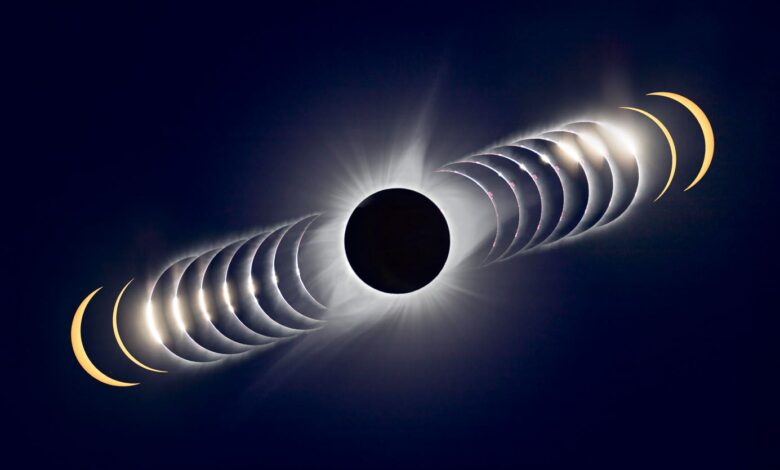19 Years From Today, A Total Solar Eclipse Will Return To The U.S.

📝 usncan Note: 19 Years From Today, A Total Solar Eclipse Will Return To The U.S.
Disclaimer: This content has been prepared based on currently trending topics to increase your awareness.
Topline
The next life-changing total solar eclipse in the contiguous U.S. is exactly 19 years away. On Aug. 22, 2044, a totality up to 2 minutes 4 seconds will come to Greenland, northern Canada and the U.S. It will be the first since April 8’s total solar eclipse was seen in Mexico, the U.S, and Canada.
A time-sequence composite of the August 21, 2017 total solar eclipse (Photo by: VW Pics/Universal Images Group via Getty Images)
Universal Images Group via Getty Images
Key Facts
On Aug. 22. 2044, a very wide path (about 281 miles/453 kilometers) will begin with a totally eclipsed sunrise in northwest Greenland, move across Canada’s Northwest Territories, British Columbia, Alberta and Saskatchewan, and end as a totally eclipsed sunset in the U.S.
Only two U.S. states will witness totality — Montana and North Dakota — with the prize the spectacle of a totally eclipsed sun just above the western horizon.
In Canada, Banff National Park and Jasper National Park are in the path of totality, as well as Calgary and Edmonton. In the U.S., Montana’s Glacier National Park and Medicine Rocks State Park are in the path, as is Theodore Roosevelt National Park in North Dakota.
Only about 5.5 million live within the path of the 2044 total solar eclipse, according to Timeanddate.
A map showing the path of totality on August 22, 2044. Courtesy of EclipseAtlas.com.
Michael Zeiler/EclipseAtlas.com
The ‘alaska Eclipse’ Of 2033
Although the 2044 total solar eclipse will be the next one visible from the contiguous U.S., the next one for the continental U.S. will occur on March 30, 2033, in Alaska. The Last Frontier state will experience totality for up to 2 minutes and 37 seconds during the best time of the year for Northern Lights. Places in the path of totality will include St. Lawrence Island, Barrow (also known as Utqiagvik), Kotzebue, and Nome.
Big Diomede Island in Russia (Tomorrow Island) and Little Diomede in the U.S. (Yesterday Island) are split by the International Date Line, so Big Diomede will experience totality one day ahead of Little Diomede.
This eclipse will occur at the peak time for the Northern Lights in Alaska, with auroras being twice as likely to appear close to the March equinox.
Total Solar Eclipses In The U.s. In The 21st Century
The U.S. is in a golden age of total solar eclipses. The U.S. has already experienced two total solar eclipses this century, on Aug. 21, 2017, and April 8, 2024. However, there are nine more total solar eclipses in the U.S. this century.
- March 30, 2033: Alaska (2 minutes 37 seconds)
- Aug. 22, 2044: Montana and North Dakota (2 minutes 4 seconds)
- Aug. 12, 2045: California, Nevada, Utah, Colorado, Kansas, Oklahoma, Arkansas, Mississippi, Alabama and Florida (6 minutes 6 seconds)
- March 30, 2052: Texas, Louisiana, Florida, Georgia and South Carolina (4 minutes 8 seconds)
- May 11, 2078: Louisiana, Mississippi, Alabama, Georgia, South Carolina and North Carolina (5 minutes 40 seconds)
- May 1, 2079: New York, New Jersey, Connecticut, Rhode Island, Massachusetts, Vermont, New Hampshire and Maine (2 minutes 55 seconds)
Further Reading



